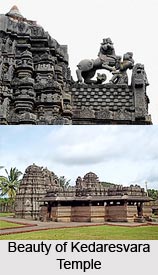 Balligavi is a town located in Shivamogga district of Karnataka state of India. Presently, it is known as Belagami or Balagame. In the ancient days, the town had names like Dakshina Kedara, Valliggame and Valligrame. Dakshina Kedara means Kedarnath of the South. The town of Balligavi lies 72 km from Shivamogga city and 21 km from Shikaripura town in Shikaripura taluk. Balligavi is known for its ancient monuments.
Balligavi is a town located in Shivamogga district of Karnataka state of India. Presently, it is known as Belagami or Balagame. In the ancient days, the town had names like Dakshina Kedara, Valliggame and Valligrame. Dakshina Kedara means Kedarnath of the South. The town of Balligavi lies 72 km from Shivamogga city and 21 km from Shikaripura town in Shikaripura taluk. Balligavi is known for its ancient monuments.
Legend of Balligavi
According to one legend, Balligavi was the capital of an Asura king (demon) and hence was called Balipura (city of Bali). Another legend says that the Pandavas visited this place while on their Vanavasa and installed the Panchalinga (five lingas); hence the name Panchalingeswara to the renowned temple here.
Golden Age of Balligavi
The golden age of this town was during the rule of the Western Chalukya Empire (10th-12th centuries). At that time, Balligavi had six mathas, three puras (extensions), five places of learning and seven Brahmapuris. The mathas belonged to Shaivas, Vaishnavas, Jainas and Buddhists. During that time, the town housed around 54 temples and supported 60,000 residents. Some of the historical records indicate that an ancient University also existed here.
Earlier to the Chalukyas, the area came under the Banavasi province of the Kadamba Dynasty. The Archaeological Survey of India had collected significant Kadamba inscriptions like the Talagunda inscriptions near Balligavi.
Kedaresvara Temple at Balligavi
Balligavi is home to a well-known ancient holy shrine called Kedareshvara temple which features Western Chalukya-Hoysala architecture. On the basis of reports from the Mysore archaeological department, it is the oldest example of such a combinational style in Karnataka.
The temple is designed with a stepped entrance on three sides. The entrance on the sides features Western Chalukya idiom. The central shrine houses a linga made from black marble, the southern shrine has a linga called Brahma while the northern shrine has a statue of Vishnu.
Attached to the vestibule there is a well designed open mantapa with two rows of pillars that connects the shrines. The ceiling of the mantapa is flat. The inner ceiling of the mantapa is carved with lotuses in them. The central ceiling is adorned with the carving of Tandaveshwara with eight guards.
The temple has a hall whose outer walls exhibit carvings of women wearing fine jewellery. Two Hoysala emblems were added in 1060 CE by Hoysala Vinayaditya. It also has a town decorated with sculptures of Tandaveshwara, Varaha, Uma Narasimha, Bhairava etc.
Notable Personalities from Balligavi
The town of Balligavi is famous for various personalities as well. It is the birthplace of the great Virashaiva saint Allama Prabhu. The place is also closely associated with Vachana poet Akka Mahadevi who was born in nearby Udugani. Balligavi is also the birthplace of Shantala Devi, queen of Hoysala king Vishnuvardhana. Many famous Hoysala sculptors like Dasoja, Malloja, Nadoja, Siddoja also hailed from here.



















